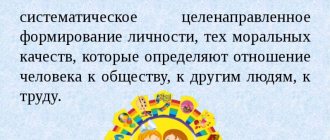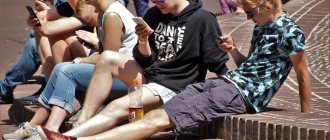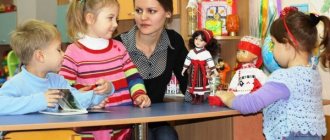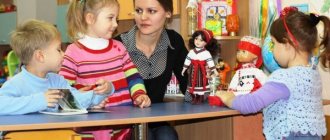Economic education of preschool children
VIOLETTA MARDANOVA
Economic education of preschool children
Report “Economic education of preschool children”
Prepared by: teacher Mardanova Violetta Yurievna
Today, each of us understands that the fate of the state depends on the economic, legal, political and moral literacy of the younger generation. Therefore, economic education is a relatively new direction in preschool pedagogy; it is currently relevant and in great demand. Questions arise: when should you start getting acquainted with economics? Is it possible to talk about the economic education of the youngest children?
Only at first glance, economics and a preschooler seem too far apart. Economics is inseparable from a child from the earliest years of his life.
The child is included in the economic life of the family very early, encounters money, advertising, goes to the store with his parents, participates in the processes of buying and selling, thus mastering economic information on an everyday, often distorted level. It is in the family that he first learns the price of labor, income and expenses, the advantages of material well-being, prosperity and the disadvantages of poverty.
It is the family that creates favorable conditions for the formation of economic thinking, awareness of the vital importance of qualities that have an economic basis. There are real life situations for this. A preschooler can look after his younger brother, wash the dishes, go to the store with his mother, and take part in putting the house in order.
Thus, he has the opportunity to learn the basics of economics, the results of labor, the first values: labor, work, money, salary, etc. Already in the senior preschool age, the child has a good sense of the family’s wealth. Proof of this: the connection between the concepts - work and money - is revealed already at the age of four or five. This is how a growing person develops his assessments, judgments, and attitude towards good and evil.
The task of teachers and parents is to help a preschooler adapt to modern reality, become a socially valuable person, correctly understand and evaluate those phenomena of the surrounding life that involuntarily invade his life.
At the beginning of the school year, we set out to introduce project activities into the practice of the kindergarten on the topic “Development of elementary economic concepts of preschool children.” Goal: to promote the development of real economic thinking and interest in economic knowledge.
Tasks:
— to form economic thinking through familiarity with economic concepts (money, goods, wages);
— introduce children to professions related to economics;
— teach to perceive and appreciate the world around us as the result of people’s labor;
— reveal the essence of the concept of “income” (wages, pensions).
- introduce children to farming;
-introduce children to the history of money;
- give an idea of banknotes (coins, banknotes) of Russia and other countries;
— to form at an accessible level the relationship between the concepts of “labor-product-money” and the fact that the cost of a product depends on quality.
This became the topic of my self-education for the 2017-2018 academic year.
The project is long-term and takes place in three stages: preparatory, main and final. The target group is children from 2 to 7 years old, since the group is of different ages. The final events were the “Fair” and “Auction of Children’s Works”.
I started by creating a subject environment and preparing methodological support. Developed lesson notes. The work was based on empirical knowledge and life experience of children, trying to clarify and expand their ideas from the field of economics.
The process of economic education is implemented through various forms of its organization.
The use of various forms gives the teacher the opportunity to show creativity, individuality and at the same time, which is especially important, to make the process of learning economics interesting and accessible. The main thing is to talk to your child about the complex world of economics in a language he understands.
Much attention was paid to three blocks of the program - “Labor-product - value”, “Useful habits and skills in everyday life” and “Money”.
The classes were conducted in the form of games and conversations: historical - the origin of money in human society, theoretical - where money can be spent, practical - where money comes from and how it is spent in the family.
First, we learned about the history of money. An excursion to a rural museum was organized, where they learned about the culture and life of the peoples of Russia, and the importance of money in people’s lives. It was necessary to explain to the children that the result of people’s labor is paid in money, to clarify their knowledge of financial categories, and to instill the principles of reasonable behavior in life situations related to money.
It was emphasized that the cost of a product depends on the material from which it is made, the time spent on its manufacture, the labor effort of the person and the quality of the work. What is the product, so is the price. During the lessons, the children and I compared objects that were identical in purpose, but different in quality (a handmade Khokhloma spoon, stamped and simple wooden; a designer cup, with a stamped pattern and a simple glass; books - soft and hard cover, newspaper and coated paper, with faded and colorful illustrations, they were taught to determine the price of a product and its grade (highest grade, first grade, defective).In order to instill in children respect for a working person, the desire to do something with their own hands and with high quality, in all cases of comparison for sample of the highest quality (grade, highest price) products with elements of original work and manual labor were selected.
Particular attention was paid to working with parents. After all, the economic education of a preschooler is impossible without the participation of parents. At all stages, the child’s support at home and in the family is required. Some areas of joint activity between the kindergarten and parents for the economic education of older preschoolers have been developed.
These include: informing parents about the tasks and content of economic education of children in kindergarten and in the family; participation of parents in the work on economic education of children in preschool institutions (economic fairs, holidays, competitions); creating an enriched developmental environment at home; reading fiction, walks and observations.
In order to interest parents in the economic education of their children, search activities were organized. Parents and children were preparing a collection of preserved ancient money and a collection of money from other countries. The result was an exhibition of coins and banknotes of Soviet and post-Soviet times, as well as foreign money.
Children become familiar with coins of different denominations in FEMP classes, learn to name them correctly, compare them, and become familiar with their exchange.
Children acquire practical skills in handling money through role-playing games. They help make economics understandable.
In role-playing games, real life situations are simulated: purchase and sale operations, production and marketing of finished products, etc. The combination of educational-game and real-life activities is most effective for preschoolers to master complex economic knowledge.
To consolidate this knowledge, role-playing games were carried out such as “Shop”, “Cafe”, “Hairdresser”, where children consolidate the skills of counting money and exchanging it.
For a more detailed study of the economy, educational activities were conducted on the topics “Family budget, income, expenses”, “Economy: market, goods, money”.
In kindergarten, children observe various types of work every day and benefit from their results. Children should be led to understand that materials, tools, and products of labor were produced for people of this profession by others. At the same time, the result of labor is used both by the manufacturer himself and by many consumers.
In joint work with adults, a senior preschooler identifies a chain of connections in the production of a product, represents its “life” labor cycle, its constant necessity.
In preschool age, work has its own specifics: children of preschool age cannot yet create socially significant values, being consumers of what adults produce for them. The way out of this situation is productive activity, organized in the form of joint partnership between an adult and children.
Productive activities of children (drawing, modeling, appliqué, design) are aimed at developing visual abilities, creativity, artistic taste, and aesthetic qualities of the individual.
In economic education, it is considered as a type of labor activity, during which the child creatively creates a product that corresponds to his interests and desires. In the process of work, they master the structure of work activity, independently managing the process of converting materials into a product of labor.
The use of different types of construction contributes to the development of children's spatial imagination, logical memory, and combinatorial abilities. At the same time, an awareness of the economic nature of the products of labor activity occurs, and experience is gained in solving simple economic problems.
In the process of modeling, children establish the dependence of consumer demand for a product (product) on the quality of its manufacture, determine the required amount of materials, and identify rational methods for manufacturing the product.
By depicting the world around them in a drawing, children develop compositional and coloristic skills and creativity. In this case, the drawing becomes the subject of conversation, expressing the economic essence of creative activity (knowledge of the world of creative professions, for example, composing advertising).
Practical consolidation of the knowledge acquired by children about the production of goods, its quality, grade and price is the manufacture of dishes from clay and plasticine in the form of the final event “Auction of Children's Works”. Children must realize that goods are the product of human labor, learn to value their own and other people’s labor, and take care of its results.
Speaking about economic and moral education, one cannot fail to mention the labor education of the younger generation.
In older preschool age, ideas about the variety of professions are formed: builder, teacher, salesman, doctor. A thematic plan for introducing children to “economic” professions will reveal the content of the work of adults, the qualities of a working person, and show the educational value of work - its transformative role. Thus, by playing in professions, children comprehend the meaning of labor, reproduce the labor processes of adults and at the same time “learn” economics. This is how preschoolers got acquainted with professions - traditional and new (advertising agent, manager, the importance of various types of work for a person. We tried to convey to the children’s consciousness that there are no bad or good, necessary or unnecessary professions, everyone is necessary. It doesn’t matter what a person’s profession is, What matters is how he does his job, what benefits he brings to people.
A fairy tale greatly contributes to the understanding of many economic phenomena, the development of cognitive interest in economics, and the creation of positive motivation for its study.
Any fairy tale (folk, original) “educates” and “educates,” that is, it carries great educational and educational potential.
Folk knowledge, which has accumulated the centuries-old economic experience of the people, is used, first of all, to educate such “economic” qualities of the individual as thrift, hard work, diligence, thrift, diligence, prudence, etc., and to become familiar with certain economic categories (“labor”, “production”). ", "distribution", "exchange", etc.).
The possibilities for using fairy tales of economic content in the pedagogical process of preschool educational institutions are extremely wide: in classes (mathematics, speech development, ecology, etc., in joint activities of adults and children (plot-based didactic games, excursions, etc.), in the free activity of children themselves (games dramatization based on the plots of fairy tales, making accessories for games, etc.).
To do this, we took an excursion to the village library, got acquainted with children's literature and updated our book corner with new books.
For a more durable and deeper assimilation of economic knowledge, we used folk and original fairy tales:
1. Reading and discussing fairy tales about needs and opportunities.
Narodnykh: “Porridge from an Axe”, “Tsarevich Ivan and the Gray Wolf”, “How a Goat Built a Hut”.
Authors: A. S. Pushkin “The Tale of the Fisherman and the Fish”, K. I. Chukovsky “Telephone”.
2. Reading and discussing fairy tales about labor.
Folk: “Terem-Teremok”, “Khavroshechka”, “Morozko”, “The Man and the Bear”, etc.
Authors: A. S. Pushkin “The Tale of the Priest and His Worker Balda”, K. D. Ushinsky “The Cockerel and the Bean Seed”, K. I. Chukovsky “Fedorino’s Grief”.
3. Reading and discussing fairy tales about money.
Author's: K. I. Chukovsky “Tsokotukha Fly”,
5. Reading and discussing fairy tales about advertising.
Folk: “The Fox and the Goat.”
Copyright: G. -H. Andersen “The King’s New Dress”, C. Perrault “Puss in Boots”, S. Mikhalkov “How an Old Man Sold a Cow”
6. Reading and discussing fairy tales about buying and selling.
Folk: "Boy with a Thumb"
Copyright: S. T. Aksakov “The Scarlet Flower”
Practical classes on the formation of economic thinking show that the economic education of a preschooler not only brings the child closer to real life, teaching him to navigate what is happening, but also forms the business qualities of the individual, which will ensure continuity between kindergarten and school.
The use of various forms and methods for the formation of economic thinking makes it possible to show creativity, individuality and at the same time make the process of learning about economics interesting and accessible.
The main thing is to talk to your child about the complex world of economics in a language he understands.
Experience shows that only joint work between kindergarten and family gives good results and contributes to a more serious and responsible attitude of adults towards the formation of economic thinking.
Early reasonable economic education serves as the basis for a correct understanding of the world and the organization of effective interaction between the child and the outside world, and the development of strategies on an individual basis. By carrying out economic education in preschool age, the problem of comprehensive personal development is solved.
Bibliography
1. Children's economic dictionary [Text]: textbook. allowance / Comp. G. V. Evmenova, O. I. Menshikova. - M.: Education, 1997. - 80 p.
2. Jugenheimer D.W., Gordon
I. Fundamentals of advertising [Text]: textbook. allowance / M.: Education, 1996. - 125 p.
3. Kozlova S. A. Theory and methods of familiarizing preschoolers with social reality [Text]: textbook. allowance/. M.: Education, 1996.- 130 p.
4. Kulikova T. A. Family pedagogy and home education [Text]: textbook. allowance/. M.: Education, - 1999. 300 p.
5. Lipsits I.V. Amazing adventures in the country “Economy”: For children of primary and secondary school age [Text]: textbook. allowance/. M.: Education, - 1992. 255 p.
6. Raizbe rg B. A., Prutchenko A. S. [Text]: Curriculum in economics (for grades 1 - 11 /. M.: Education, - 1992. 280 p.
7. Sasova I. A. Economic education of children in the family [Text]: textbook. allowance/. M.: Education, 1996.- 125 p.
8. Smoltseva A. A. Introduction to the world of economics, or how we play economics:. [Text]: Educational and methodological manual. /. S. P. b. : "CHILDREN'S PRESS", - 2002.,. 150 s.
9. Shatova A. D. Preschooler and. economics [Text]: textbook. allowance/. M.: Education, 1996.- 200 p.
Economics and preschooler
The economy and the preschool child seem too far apart only at first glance. Understood as the field of "wise housekeeping", the art of economics can be taught to children in the form of elementary information:
- Teach them the correct attitude towards money, how to earn it and use it wisely;
- use games, economic problems, crosswords to introduce children to the complex world of objects, things and human relationships
- The connection between economic and ethical categories: Labor, goods, money, value, price, on the one hand, and moral categories: “thrift, honesty, frugality, dignity, generosity,” on the other.
- teach how to properly treat advertising and deal with it;
- behave correctly in real life situations, develop significant needs.
The child participates in economic processes. He goes to the store with his parents, sometimes he does the shopping himself, and whether we like it or not, he still has economic experience. Therefore, the teacher’s task is not only to convey a certain amount of economic knowledge, but, very importantly, to teach how to correctly apply this knowledge, that is, to educate an economist.
Based on the above, A.A. Bogdanov proposes to include the following key topics in the economic education program for preschoolers:
- my country and family.
- family income.
- family cost.
- current and future family budget.
- family savings and their use.
As a result, according to A.A. Bogdanov, a preschooler should:
- Know the basic economic concepts and categories covered in class;
- Be able to weigh your needs and capabilities; Understand that money “grows” when it is kept in a bank (and not in a piggy bank); To feel that their family is involved in the development and strengthening of the state and that there is an inextricable connection between them;
- learn that wages are payment for the quantity and quality of labor and a pension for past work, and alimony is an advance paid to children in anticipation of their future work; that family expenses should not be wasteful, and a thrifty child can increase them, that advertising, if true, can help and, conversely, harm the family budget; that family savings are money that can remain if spent wisely, and can be used for a vacation for the whole family or buying necessary but expensive things, etc. P.
- Realize your importance for family and society; responsibility for one’s actions, which may positively or negatively affect the economic situation of the family and oneself.
Scientists of the Russian Academy of Education have developed and adopted a unified concept of economic education for children and adolescents, according to which education begins from preschool age.
A. Shatova’s program “Preschoolers and ... Economics” seeks to lay the foundations of an economic way of thinking, an awareness of what “I” is in the world of economic values and how to behave in it. Already in preschool age, the child moves from the usual role of a carefree consumer to a conscious consumer, and then to the creator of consumer goods. This is the key to a new way of thinking and a new attitude towards life.
The process of formation of economic thinking
An analysis of psychological and pedagogical literature shows that the problem of the content of economic education for preschool children is complex and ambiguous. In fact, economic education as a process of forming economic thinking, developing business qualities, social activity and entrepreneurship is only partially applicable to preschoolers, due to the age-related characteristics of their mental development.
HELL. Shatova believes that “the purpose of labor in economic education is to instill in children the correct attitude towards what adults have done and are doing for them, respect for human labor, thanks to which an “objective world that ennobles life” has been created.”
Economic education of preschool children should emphasize its relationship with moral education. In conditions of capitalization of the economy, the younger generation’s ideas about justice and honesty often shift towards permissiveness, materialism, selfishness and the desire to get rich at any cost.
The period of senior preschool age is the most favorable for the formation of the first ideas about the moral and legal foundations of the market, which, according to B.T. Likhachev, “are the simple rules of human morality”: Honesty, strength and reliability of a given word; politeness, respect for employees, partners, and consumers.”
For the effectiveness of the process of economic education of children of senior preschool age, researchers have determined optimal pedagogical conditions. Let us dwell on the first condition - the creation of an economically educational environment aimed at the formation of such moral and economic qualities of the individual as thrift, responsibility, business sense, entrepreneurship, ensuring life in society.
Based on the research of I.I. Pidkasisty, the environment of economic support is understood as a set of phenomena and events that surround the child, influence his personal development and contribute to his entry into the world of socio-economic relations.
The contents of an economically supported environment include:
- object-spatial environment (creation of a gaming economic zone);
- socio-behavioral environment (parents, teaching staff of a preschool educational institution);
- event-cognitive environment (excursions, meetings with interesting people);
- Information environment (crosswords, illustrations, layouts of stores, banks, service centers, coin samples, map of industrial enterprises of the city).
A teacher who professionally uses the influence of these social agents gives this influence a target orientation, transforming the social situation of development into a pedagogical one - creating an educational environment aimed at the formation of leading moral and ethical qualities.
In preschool age, moral feelings begin to form, which are important for the development of decent relationships. The sincere attitude of adults towards someone or something soon turns into the attitude of children towards the same persons and phenomena, expressed in corresponding morally oriented feelings. There is an active desire to help and support each other. The emergence of friendship between children and a caring attitude towards each other occurs on the basis of the first forms of a sense of duty and responsibility.






